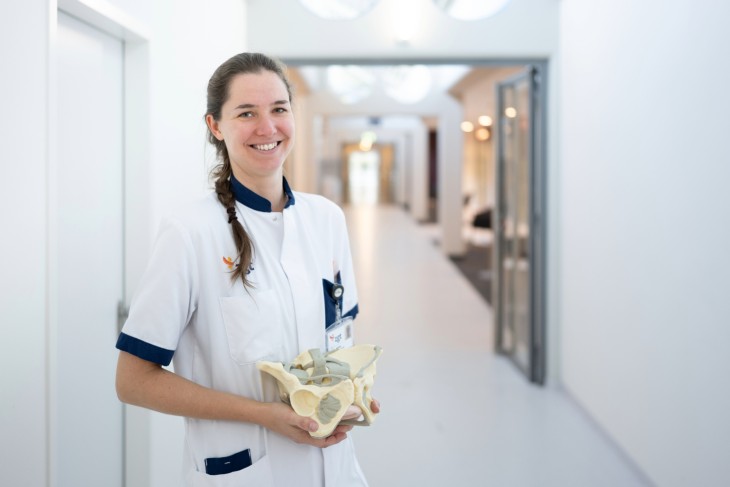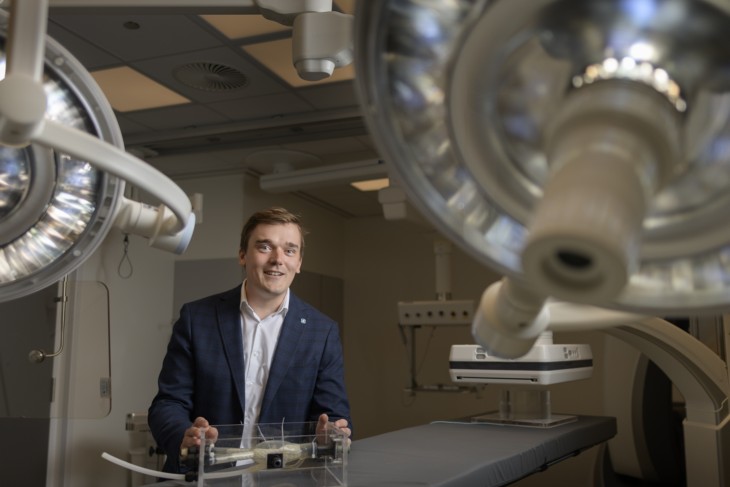Bosschaart conducts research into breastfeeding at the Faculty of Science & Technology. Together with colleagues, she is developing new methods to look into both the milk and the breast. This has led them to be among the top three finalists for the Klokhuis Science Prize, awarded by the television programme of the same name. This prize is intended to familiarise a broad and young audience with Dutch scientific research.
Unanswered questions
Breastfeeding has several positive effects on the health of both baby and mother. However, breastfeeding is not easy for everyone. Bosschaart: "I myself have enjoyed breastfeeding my two children. It is fascinating how the body can adapt to this situation, but at the same time I saw in my environment that breastfeeding can also be very difficult." For example, many mothers struggle with the question of whether they are producing enough milk for their child. In fact, this is the main reason for stopping breastfeeding. Bosschaart clarifies: "On the one hand, it may be a perception issue. In that case, there is enough milk but the mother feels there is not. In practice, we see that a lactation consultant then can help boost self-confidence of the mother and possibly improve breastfeeding techniques. But there are also indications that, in some cases, the cause of the problem may lie in the breast itself. Then, you need methods to be able to measure. Is there enough glandular tissue to make milk? Is there enough blood in the glandular tissue to supply all the ingredients for the milk? And will it be possible to transfer that milk to the child? We cannot yet answer those questions properly."
Looking inside the breast
The researchers remain in the dark due to the lack of effective measurement techniques. That is why Bosschaart and her team aim to develop several new techniques. Bosschaart: "First of all, we focus on techniques to look inside the breast. We are developing an optical method: a scanner based on light, which can be moved over the breast. The advantage of light is that it is safe and easy to apply. With this technique, we are sensitive to a number of things, such as the amount of glandular tissue, the supply of milk ingredients through the blood and the let-down reflex – the reflex that causes milk to flow out of the breast." Bosschaart and her team are currently testing this technique. They are also using MRI to study breastfeeding. That way, they employ both new and established techniques to investigate what happens before, during and after breastfeeding within the breast.
Milk flow and composition
Another technique under development aims to analyse the milk itself. With this, the researchers want to measure both the milk flow and the composition of breast milk. Bosschaart: "We want to know what a child drinks at the breast. For example, how much milk, but also what is in the milk and how that changes throughout a feeding." Again, the researchers use light for this. Bosschaart explains why: "Measuring with light has many advantages. Light-based techniques are compact, so you can integrate it well into a small sensor. In addition, it is relatively inexpensive, safe and harmless.” According to Bosschaart, the new method is particularly interesting from a research perspective, especially when combined with studies on what happens inside the breast. However, it could also have practical applications in breastfeeding support.
Breastfeeding support
In practice, breastfeeding is not an unspoken topic. Mothers who experience difficulties with breastfeeding can seek support from a lactation consultant. Bosschaart: "Those healthcare providers can observe the breastfeeding process and help with the baby’s latch and drinking technique. Fortunately, a lot is already known about that. But what exactly happens within the breast remains largely unknown. More research is definitely needed for that. If we gain a better understanding of how breastfeeding works, we can eventually help mothers and babies even better."
Future aspirations
Bosschaart and her team are currently developing new technologies. What comes next? Bosschaart says: "Using these technologies in breastfeeding research. Investigating how breastfeeding works. Better understand the fundamental biology of breastfeeding. My dream for the future is that our current research will eventually lead to more self-confidence and insight among breastfeeding women."



